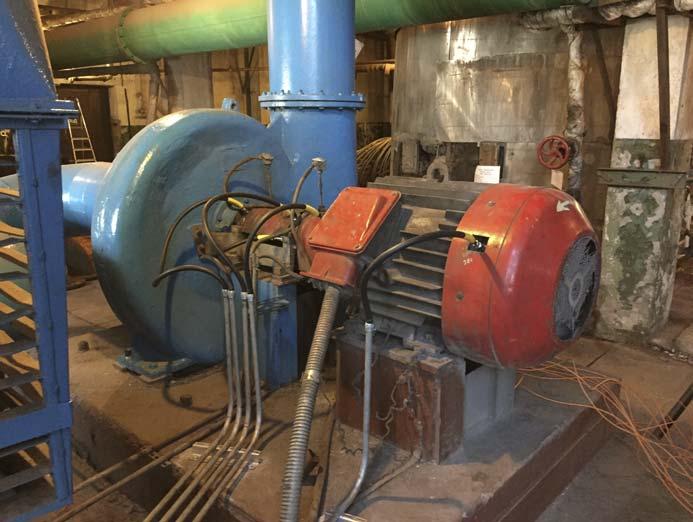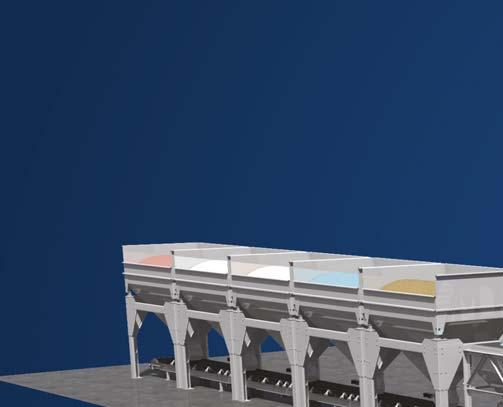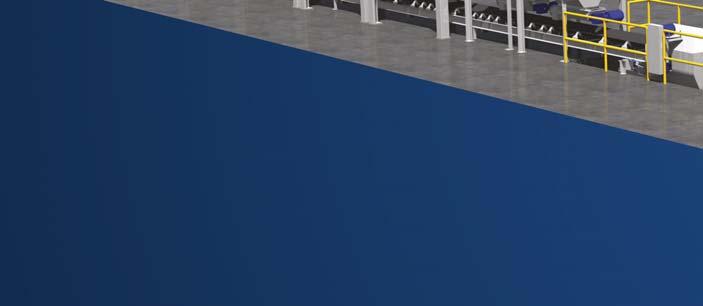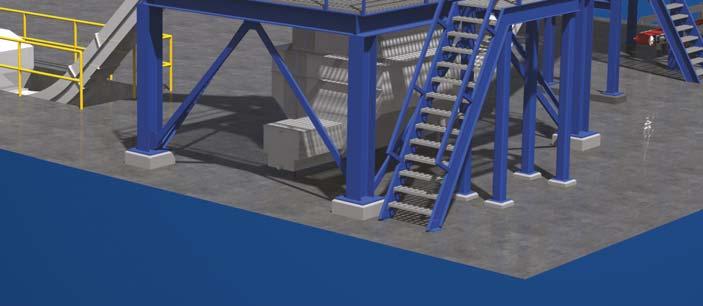
9 minute read
Managing Critical Machines


MANAGING MACHINES
Alexey Vostrukhov and Michael Hastings, Brüel & Kjær Vibro GmbH,
Germany, explain how, faced with challenging maintenance issues, the Angarsk nitrogen fertilizer plant in Russia decided to adopt a technologically advanced machine condition monitoring strategy.
Each year, 21.6 million t of ammonium nitrate (AN) are consumed to help increase food production for billions, and the Angarsk nitrogen fertilizer plant (Angarsk Azotno Tukovy Zavod, or AATZ for short) plays an important role in this production. AATZ is currently producing the following nitrogen fertilizers and feedstock products: 270 000 tpy of AN, including porous AN (used for explosives in the mining industry). 225 000 tpy of non-concentrated nitric acid (minimum 46%). 10 000 tpy of aqueous ammonia.


AATZ, modernised and commissioned in 2004, has its origins in fertilizer production in 1962. Since then, it has been upgraded, expanded and changed ownership several times until 2011, when AATZ was merged into SDS Azot. The company has other plants that produce a combined total of over 1 million tpy of AN, 300 000 tpy of ammonium sulfate, 120 000 tpy of caprolactam and 1 million tpy of urea.
Machines need attention
At AATZ there are a number of critical machines used in the fi ve production lines of the Haber-Bosch process for producing ammonia and converting it into nitric acid and AN. Some of these machines are relatively old and there have consequently been recurring maintenance issues, especially for those with rolling element bearings (REBs). The blowers used in the ammonia-air mixing process, shown in Figures 1 and 2, are good examples of these. FlexControls, one of the Brüel & Kjær Vibro channel partners in Russia, was asked to give a proposal for addressing the problem, looking fi rst at the fi ve blowers.

Asset optimisation through digital transformation
Figure 1. One of the five blowers used in the ammonia-air mixing process at AATZ.
The Brüel & Kjær Vibro VC-8000 SETPOINT CMS system was selected for the task of condition monitoring the blowers, as well as providing automatic decision support for diagnostics. One of the main reasons for selecting this system was it already had a process information interface with the existing OSIsoft PI historian at AATZ. This means vibration data can be stored and viewed in the PI system together with process data. No proprietary database server is needed, and user management is more accessible without restrictive licensing. Moreover, the process data can be correlated together with the vibration data, so it is easier to see which events are process-related and which are an indication of deteriorating machine health. One of the key aspects of the system’s PI interface is that time waveform data can also be stored in the PI system. This means events can be manually post-processed at any time using the Setpoint diagnostic technique package, or by third-party systems. In addition to manual diagnostics, there is an automatic system as well, which will be described later in this article. The plant is also using the Rockwell Automation system FactoryTalk, a manufacturing execution system (MES) that provides enterprise-wide operational intelligence for process optimisation. Figure 2. The blower being monitored is in the catalytic ammonia oxidation converter This is achieved through production performance process, shown in red. analysis of the process, which ultimately results in reducing IT support costs, improving scheduling efficiency and reducing equipment downtime. FactoryTalk Analytics, which is interfaced to the PI system, uses much of the data from Setpoint for asset maintenance management. Most of the process visualisation is achieved with an entirely different system known as SCADA FTView, shown in Figure 3. Altogether, these interfaced systems work closely together within the IoT drive to converge IT/OT functions through a digital business Figure 3. Process view of the five blowers, showing the alarm status of each. transformation.


Automatic decision support for diagnostics
The condition monitoring functionality of the Setpoint system employs automatic fault detection and diagnostics for REBs. Historically, the bearings on the older blowers have been failing at non-predictable times due to both wear and lubrication problems. This has been a concern for the AATZ maintenance staff for several years, so one of the main requirements for the new condition monitoring system was that it should address this issue.
The diagnostic rules implemented at AATZ were based on the experience of two other production facilities in Russia using the Setpoint system: the Omsk Poliom plant and the SIBUR ZapSib-2 OPF plant, both of which produce polyolefi ns.
At present, the following parameters are monitored: REB fault frequency detection – defects on the inner race, outer race, cage and rolling elements generate impacts that can be detected by filtered acceleration measurements, if the carpet noise is low in relation to the bearing fault frequencies. A frequency range is monitored where all the REB defects occur (also known as prime spike frequency range), which is typically between 1 to 7 times the ball passing frequency on the outer race. This technique is used for early detection of REB faults. High-frequency demodulation spectra (HFD) – this technique can isolate and detect inner and outer race faults regardless of the noise carpet level. All bearing fault frequencies can excite component resonances, but the inner and outer race fault frequencies can also modulate this resonance (i.e. carrier frequency) because of the variable load zones. By filtering out the acceleration low-frequency vibration signals, demodulating the carrier frequency and then filtering it out, the original inner and outer race bearing fault frequencies are isolated. Just as importantly, these same fault frequencies can also give an indication of improper lubrication, which is one of the primary uses for this measurement.
In addition to these, there are a number of other measurements that are calculated and used for trending, such as the overall vibration level and the 1x and 2x running speed bandpass measurements.
The MES takes in the fault detection and diagnostic information from the automatic diagnostic system and relays this to the operators in the form of alarms, as follows: Green: no defects. Yellow: minor defects. Orange: serious defects. Red: extremely serious defects – not allowed for operation.
These alarms refer to the specifi c bearings in question.
As a diagnosis is automatically made at the same time the fault is detected, there is no need to wait for a


Helping them grow!
GEA offers process solutions for economical and sustainable fertilizer production
Expertise, technologies and equipment that meet your requirements.
Our unit operations include • evaporation and crystallization • centrifugal separation • drying (rotary and fl uid bed dryer) • solid cooling (contact fl uidizer and cooler) • rotary granulation and coating • dedusting (bag fi lter and wet scrubbing)
In-house test facilities and customeroriented service concepts guarantee a seamless support for instant productivity and performance.
For contact details: gea.com/contact
diagnostic specialist to manually perform the same analysis during working hours or after holidays, which may be too late if it is a question of lubrication problems. The operator can react immediately when the fault occurs and inform the maintenance technicians about what type of problem occurred and where. This system greatly simplifies the decision-making process for taking maintenance action and speeds it up without requiring the immediate need for a specialist, who may not be available at the time.
Experience up to now
As the monitoring system has been completely operational for almost one and a half years now, several cases have come up that confirm the fault detection and automatic diagnostic capabilities of the system. Not long after the monitoring system was commissioned, one of the operators at AATZ received the message “Lack of Grease in Bearings of Motor #1”. The operator thought this was a false positive alarm but ordered his team to stop the machine anyway. They opened the electric motor casing and found only 30% lubrication. When they added grease and started the machine up again the alarm stopped, confirming that the diagnostic rules were working as intended.
There were other, more serious, malfunctions such as foundation soft foot (Blowers #3 and #10), as well as loose bearings (Blowers #1 and #3). One recent problem that has occurred several times in the past has been detection of excessive 1x vibration. This is due to the ammonium salt deposits on the ammonia-vapour blower blades, which causes unbalance. It is important to carefully monitor this condition, since if it is not corrected in due time the bearings can be overloaded and fail prematurely. The blowers are quite old and need considerable attention. The new monitoring system not only helped the maintenance technicians to initiate work orders, but they also gained a better understanding of their assets.
Overview
The system has been fully operational for approximately a year now and includes an automatic decision support system for diagnostics, which improves the reliability and speed for making asset maintenance decisions. In addition to this, vibration and process data are saved in the OSIsoft PI data historian for correlation purposes, which is also integrated into the FactoryTalk Analytics and Connected Services MES system for process optimisation and asset maintenance management and utilisation.
By starting off and monitoring only the five blowers at AATZ, this has given the maintenance technicians an excellent opportunity to gain experience in working with the monitoring system. There are still a number of other machines that are old and in need of condition monitoring, so there are plans underway to extend the monitoring system to the nitrous compressors for the nitrogen dioxide absorption columns, shown in Figure 2, as the next step.





















